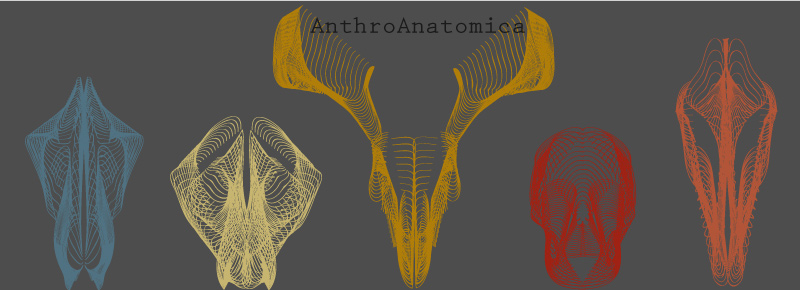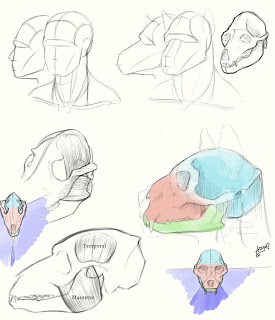 |
| Some main human facial movements compared with those need for an anthro' character with a longer muzzle. |
Tuesday 20 November 2012
Expression
Sunday 18 November 2012
Skull Ideas
Sunday 4 November 2012
Comparative Skull Proportions
Each skull is divided simply into 3 parts; red - the maxilla and the plains of the 'face'; green - the mandible; blue - the cranial vault; yellow - the Axis (1st cervical vertebra). Each represents to a rough scale the respective size of each skull element in a) human, b) canine and c) equine. Note the cranial vault does not directly represent respective brain size.
I've started with a thought on the sentient issues of anthro' characters. We would expect our characters to the be the singing, dancing types of the average human. So if we take the casual assumption that to have the same level of intelligence means having the same brain size of a human we soon need to adjust the proportions of the skull to accommodate this. Fig 2 indicates a size of the cranial vault in blue of a human (a) that we'd need to apply to our animal skulls. How then do we balance this with the large jaw and jaw muscles of a herbivore or carnivore? What changes does a larger cranium make to that of the facial plains, particularly the Zygomatric (or cheek bones), the position of the eyes and visual field? We have a number of considerations to make and plenty of permutations dependent on species...
Labels:
anatomy,
canine,
comparative,
equine,
furry,
human,
proportions,
skull
Thursday 18 October 2012
S-spine, C-spine
Comparison of axial skeletons of a human and canine, arrows note the number and directions of each spinal curve. (Not to scale).
The spines of each system are therefore adapted to cope with each of these extremes. The S-shape spine of a biped has 4 notable curves, creating it's distinctive S shape. This maintains the centre of gravity when standing from the top of the spine down through the feet. These curves also facilitate weight transference with minimal effort.
The C-shape spine of quadrupeds have only 3 notable curves that are near opposite to biped curves. The C-shape comes from the thoracic and lumbar regions curving upwards. I've drawn the canine above stood upright, this would bring it's centre of gravity in front of its feet, causing it to be unbalanced and fall forward. The curvature of its spine, particularly at the lumbar region would not support the weight of an upright torso, the curve is in the wrong direction.
This shows that we simply can't start our anthropomorphic characters by just standing a quadruped up on 2 feet. This and other anatomical issues make this a poor starting point, however, should we wish to maintain a degree of our chosen animals features in our anthropomorphic bipeds we can start adapting this anatomy into likely possibles. Lets explore these possibilities...
Labels:
anatomy,
anthro,
biped,
comparative,
furry,
human,
pelvis,
quadruped,
rib,
ribcage,
spine,
vertebral column
Subscribe to:
Posts (Atom)





